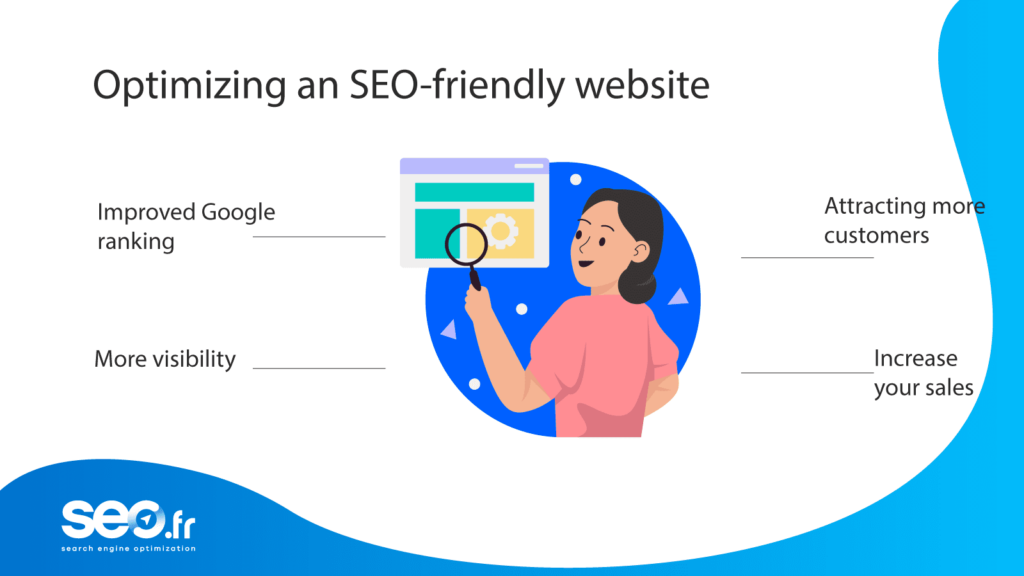Most websites do not meet the criteria for good SEO. They do not take into account the requirements of search engines or the user experience. They contain duplicate content and incorrect markup. As a result, they sink into anonymity. Do you have an SEO-friendly site? Do you know how important this is to your company’s digital growth? Natural referencing is one of the best marketing solutions for reaching search engines. Unlike adword advertising, it allows you to be visible on the first page of Google without paying.
Whether you use the WordPress CMS, Drupal, Shopify or other design tools, you need to build a site that is SEO-friendly. To do this, optimize your web pages so that they appear first in Google search. How can you do this? In this article, we reveal the important SEO actions and steps for creating and referencing your site.
What are the key factors?
To launch a site that easily rises in the search engines, think about users and robots. Check whether robots have indexed your site. To do this, perform a simple Google search. Enter your domain name or the URL of your site in the search bar to see if your shop window appears. When you’re just starting out online, these different elements will help you find your site easily. Want to reach the top of the search results?
Create an SEO-friendly site
Designing a site that is optimized for search engine optimization requires an optimal structure. The simpler and more accessible the architecture of your website, the easier it will be for Google’s crawlers to crawl it. Remember that robots crawl, read and classify more than twenty billion web pages every day. When you optimize your site’s tree structure, you make their job easier. They explore your content correctly and index it.
Good technical SEO also improves the user experience. Internet users can easily access your content and offers without having to struggle. No matter how they get to your shop window, they can clearly understand what you have to offer. You make their journey pleasant. As a result, you reduce your bounce rate and further improve your SERP ranking.
To optimise the structure of your site, you may want to :
- Create a home page, category pages and product pages. Allow your visitors to browse the information available on your site by category and sub-category. If, for example, you want your e-commerce shop window to be an SEO-friendly site, think about setting up search options. By doing so, you help your customers to easily find what they come to your online shop for.
- Insert transition pages that will serve as an entry point for your website’s category pages.
- Create a practical navigation menu.

Understand the search engine game
To carry out your web project and be visible in the long term, organic referencing is the best solution. However, this web marketing lever may require you to take a number of actions. As you know, having a digital strategy is not enough to get your site on the first page. Google referencing takes time and ongoing effort. Let’s explore the best practices for winning over the search engines.
If you already have a site and want to redesign it, start with an SEO audit. This will show you what is blocking your search engine optimization, and then identify the best ways of optimizing your shop window. You can then make good use of Title tags or take account of Hn tags. Improve images for organic referencing. To make your site SEO friendly, you can improve the UX of the web page and present a better experience to visitors to your site. You can also revise the internal linking and choose the right URL for each web page.
You will no doubt have noticed that all these actions are carried out on the site. However, as we mentioned earlier, creating an SEO-friendly site goes beyond on-site SEO. You need to include off-page SEO actions. To this end,
- Build links: get backlinks by writing guest articles on a specific issue.
- Use content marketing in a different way: create and publish an infographic that gets a link from a reputable newspaper.
- Leverage brand building.
- Exploit social platforms.
- Implement a strategy to develop your local presence.
- Use influencer marketing.
- Use guest posting, etc.
What is ‘on-site’ SEO?
On-Page SEO refers to all the tasks you carry out on your website. It involves optimizing web pages internally to make them easier to find in search engines. The SEO actions you take are aimed exclusively at improving the performance of your online shop window. They enable you to obtain a better ranking in the SERP.
When you work on on-site SEO, you often encourage Google to explore your web pages. It can then index them according to its ranking criteria. But having an SEO-friendly site isn’t just about winning over the search engines. You also need to provide a good user experience by minimizing clicks.
As you can see, on-site SEO gives you a responsive, user-friendly shop window. To achieve this result, you also need to take into account measures external to your site. In this way, you can improve the ranking of your professional site or e-commerce shop window in search results. Basically, creating an SEO-friendly site requires a combination of on-site and off-page SEO. It allows you to :
- Create optimized pages.
- Be visible on Google, Bing, etc.
- Increase your conversion rate
- Connect your products or services to new customers.
- Raise your profile.
Got an SEO question?
Julia can help
8 years’ expertise in SEO

How do you create a website with good SEO?
There are two ways to build a responsive site that appears in search engines without going down the paid search route. Seek the support of a web agency or go freelance to save time and improve efficiency. Communications agencies allow you to create your own SEO-friendly site with the help of an experienced team. You’ll benefit from the services of a graphic designer, a developer and web marketing experts, among others. All these professionals work together to bring your web project to fruition.
The second alternative is to seek the assistance of a freelance webmaster. They can take care of building your site. Of course, he will also help you create the content of your site if he has the talents of a good writer. However, their service will not be as comprehensive as that of a digital agency. Whichever option you choose, take a look at your service provider’s portfolio, and you’ll find out what he’s really capable of by looking at what he’s done in the past.
You can also easily create your own site if you wish. All you need to do is choose an easy-to-use website creation software such as Shopify, WordPress or Prestashop. These different design tools offer thousands of customizable templates using drag-and-drop functionality. In effect, they make building a site child’s play. You should be aware, however, that there are certain fundamental rules for referencing a site, which you should not ignore if you want to get back on the first page of Google results.
So what are the essential steps for creating a responsive, SEO-friendly site?
Would you like your site to be optimized for search engines? Discover the 8 essential steps for designing an SEO site, starting with a domain name.
- Choose a good web host for your website. With quality web hosting, you can improve the ergonomics of your site. You can easily manage your web showcase. You get better security and legal protection. To do this, opt for a web host with an SSL certificate and SSD hard disks. This allows you to optimize your site’s changeover time.
- Use a responsive web design that adapts to different media such as computer, tablet and mobile.
- Configure your site for SEO. If you are using the WordPress editor, for example, you can access the settings. You select the different aspects that can be modified. This may involve writing a description or installing extensions or plugins such as Yoast SEO or Rank Math.
- Create your pages and your SEO-optimized texts based on the keywords you want to rank for. For your web pages, use one keyword per page and work on semantic enrichment. Make sure that your content is unique and of high quality. For your blog articles, give priority to long-tail keywords.
- Give preference to a correct structure for the content and titles of your site.
- Use good mark-up.
- Encourage internal and external linking.
- Connect your site to Google Analytics to monitor and improve your SEO performance.
Did you like this article? Read all the latest web marketing news on our seo agency blog.









